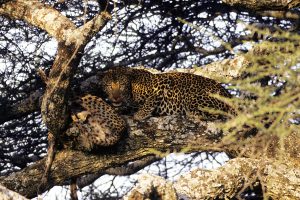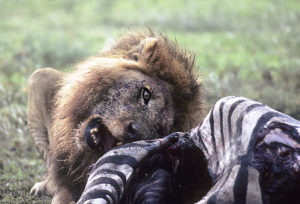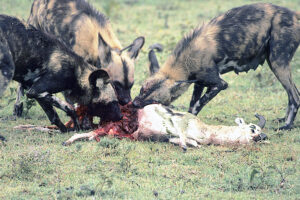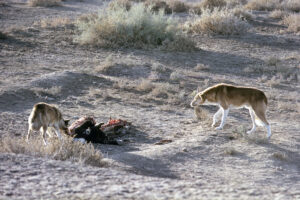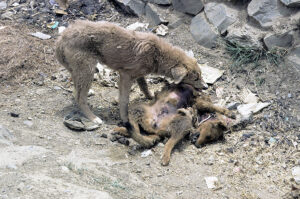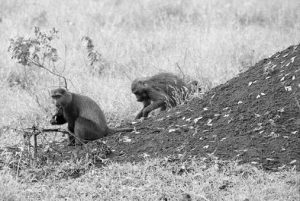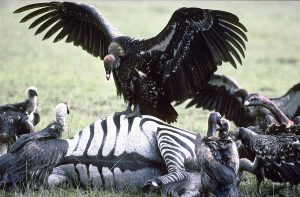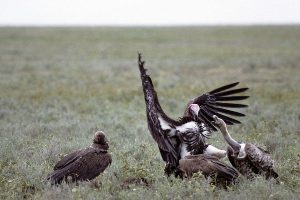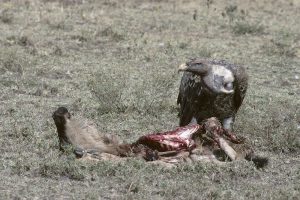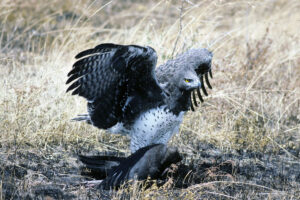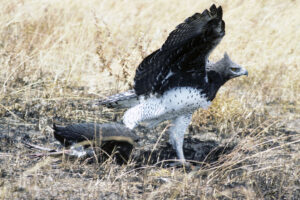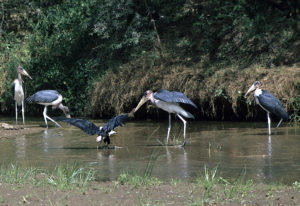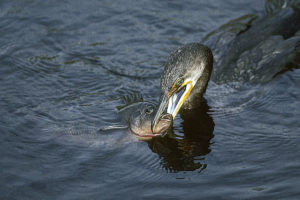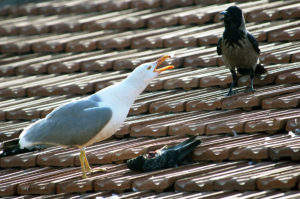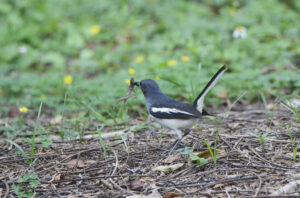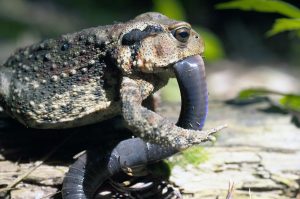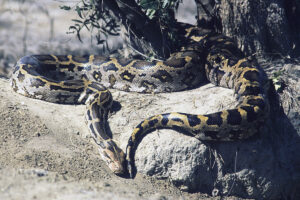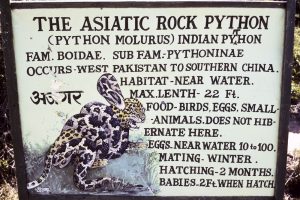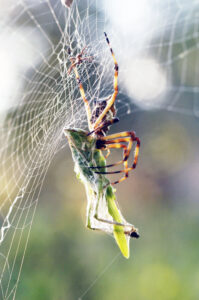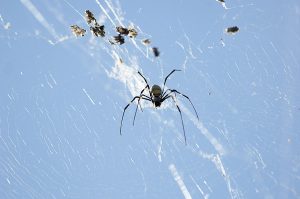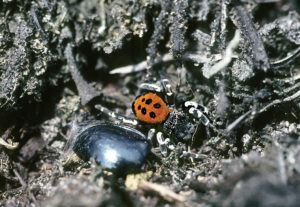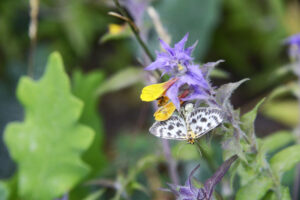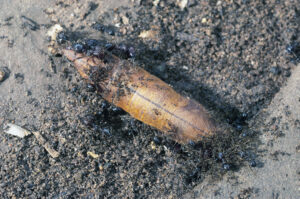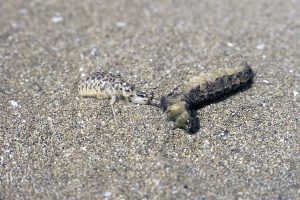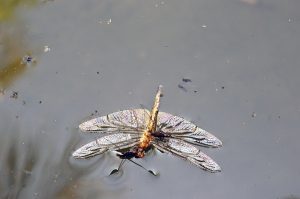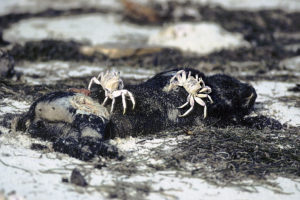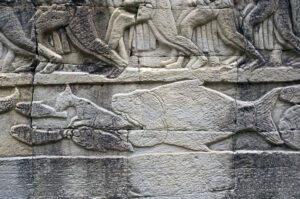Predator and prey
Illuminated by the setting sun, this leopard is eating his cousin, a cheetah (Acinonyx jubatus) – a very rare incident, since cheetahs are able to run much faster than leopards. Either this particular cheetah was wounded, or the leopard surprised it by jumping on it from a tree. – Serengeti National Park, Tanzania. (Photos copyright © by Kaj Halberg)
Cats
The leopard (Panthera pardus) has a very wide distribution, from Ussuriland in south-eastern Russia southwards through parts of China and Southeast Asia to Indonesia, and thence westwards through the Indian Subcontinent to the Middle East, and most of sub-Saharan Africa. It has adapted to a huge variety of habitats, from tropical jungles to semi-desert and mountains, and even farmland near villages.
The leopard is described in depth on the page Animals – Mammals: The spotted killer, including the story of a terrible man-eating leopard in northern India.
This large male leopard is panting heavily, satiated after feeding on a white-bearded wildebeest (Connochaetes taurinus ssp. mearnsi), which he has dragged up into a sausage tree (Kigelia africana). – Serengeti National Park. (Photo copyright © by Kaj Halberg)
The cheetah (Acinonyx jubatus) is the fastest land mammal on Earth, during hunts often running at speeds of up to 64 km/h, being able to accelerate up to 112 km/h on short distances. Because of this ability, it was tamed as early as the 16th Century B.C. in Egypt, and later also in India, to be used for hunting.
This species is described on the page Portraits, and pictures of it are found in the gallery at Animals: Cats.
The cheetah in front is feeding on an impala (Aepyceros melampus), while its satiated companion is resting in the shrubs, panting. – Serengeti National Park, Tanzania. (Photo copyright © by Kaj Halberg)
Lions (Panthera leo) live in prides, consisting of females and young, and a single or several males. If there is more than one male, they are brothers or half-brothers. Even if they often don’t participate in a hunt, the stronger males will chase away lionesses and cubs from a prey, if it is not large enough to feed the entire pride.
The lion is unique among cats due to the male’s mane, a large growth of hair around the neck and down the chest, and often a little way down the back. The mane makes a male lion look larger than he actually is, without the disadvantage of a larger weight, which would require more food. A large mane is a signal to other males that here comes a powerful animal that shouldn’t be challenged, even if the challenging male is in fact larger than his opponent, but has a smaller mane. The mane also gives some protection during fights among males, for instance when stray males attempt to take over a pride.
The lion is described in depth on the page Animals – Mammals: Lion – king of the savanna, and an unusual nightly encounter with lions is related on the page Travel episodes – Tanzania 1990: Lions in the camp.
This lone, ageing male lion in Serengeti National Park, Tanzania, is feeding on the carcass of a plains zebra (Equus quagga ssp. boehmi). (Photo copyright © by Kaj Halberg)
This young lion is feeding on a white-bearded wildebeest (Connochaetes taurinus ssp. mearnsi), while its satiated companion is sleeping next to it. – Tarangire National Park, Tanzania. (Photo copyright © by Kaj Halberg)
Dogs
The African hunting dog (Lycaon pictus) has declined dramatically during the last hundred years. This fascinating animal is described on the page Animals – Mammals: Hunting dogs – nomads of the savanna.
These African hunting dogs are gorging themselves on a Thomson’s gazelle (Eudorcas thomsonii), Serengeti National Park, Tanzania. (Photo copyright © by Kaj Halberg)
The complicated ancestry of the domestic dog is described on the page Animals: Animals as servants of Man.
These dogs are feeding on a dead donkey, near Raqqa, Syria. (Photo copyright © by Kaj Halberg)
An example of cannibalism: A hungry dog, eating from a dead pup, Shigatse, Tibet. (Photo copyright © by Kaj Halberg)
Other mammals
A blue monkey (Cercopithecus mitis) and an olive baboon (Papio anubis), feeding on swarming termites, which are leaving their mound, Lake Manyara National Park, Tanzania. Both species are described on the page Animals – Mammals: Monkeys and apes. (Photo copyright © by Kaj Halberg)
Birds
The African white-backed vulture (Gyps africanus) was once widespread and common in sub-Saharan Africa, occurring from the Sahel zone in West Africa, eastwards to Ethiopia and Somalia, and thence south through East Africa to South Africa and Namibia. Sadly, this species is now undergoing a rapid decline. The global population has been estimated at 270,000 individuals.
Rüppell’s vulture (Gyps rueppelli) occurs throughout the Sahel region, and also in East Africa southwards to Mozambique. Formerly abundant, this species may now count less than 20,000 individuals.
Both these vulture species have declined by over 90%, especially in West Africa, and they are now regarded as critically endangered. (Source: iucnredlist.org)
The pictures below were all taken in Serengeti National Park, northern Tanzania.
African white-backed vultures and Rüppell’s vultures, gathered around a pregnant plains zebra (Equus quagga ssp. boehmi), which has just been struck and killed by lightning. (Photo copyright © by Kaj Halberg)
A Rüppell’s vulture, which was feeding on the remains of a white-bearded wildebeest calf (Connochaetes taurinus ssp. mearnsi), defends its meal against an intruding lappet-faced vulture (Torgos tracheliotos). (Photo copyright © by Kaj Halberg)
This Rüppell’s vulture is also feeding on the carcass of a white-bearded wildebeest calf, which was probably killed by lions. (Photo copyright © by Kaj Halberg)
The martial eagle (Polemaetus bellicosus), which is native to sub-Saharan Africa, is a large and very powerful eagle, which primarily hunts by soaring and then suddendly swooping down on its prey. It is described on the page Animals – Birds: Birds in Africa.
This martial eagle in Serengeti National Park, Tanzania, has caught an Abdim’s stork (Ciconia abdimii). As our vehicle got too close, the eagle grabbed the stork with one foot and walked som distance away with it. (Photos copyright © by Kaj Halberg)
The African fish-eagle (Haliaeetus vocifer), which is widely distributed in sub-Saharan Africa, always lives near water. This iconic raptor is the national bird of no less than three countries: Zambia, Zimbabwe, and South Sudan.
This species was described by French naturalist François Levaillant (1753-1824), who named it vocifer (’the one who has a penetrating voice’) – a most suitable name for this eagle, whose scream is often resounding over the African landscape.
This African fish-eagle has just caught a fish in Lake Malawi. (Photo copyright © by Kaj Halberg)
An African fish-eagle attacks a marabou stork (Leptoptilos cruminifer), as the stork attempts to steal its food, consisting of the remains of a goat, which was hung up in a tree to lure leopards to the place, Samburu National Park, Kenya. (Photo copyright © by Kaj Halberg)
The double-crested cormorant (Phalacrocorax auritus), which is divided into five subspecies, is very common in most of North America, from the Aleutian Islands in the Bering Sea southwards to northern Mexico, and across the continent to eastern Canada, southwards to the Bahamas.
The specific name auritus means ‘eared’ in Latin, which, like the common name double-crested, refers to its twin crests, one on each side of the head, during the breeding season.
Numerous cormorant species are described on the page Fishing.
This double-crested cormorant in Everglades National Park, Florida, has just caught a fish, grabbing it with its strong beak, which is equipped with a hook. (Photo copyright © by Kaj Halberg)
The western yellow-legged gull (Larus michahellis) is found in the Mediterranean Sea. This species resembles the widespread herring gull (Larus argentatus), but can be identified by its yellow legs and very powerful beak.
It is extremely common in Istanbul, Turkey, where it often breeds on house roofs. If a window is left open, it may enter to search for edibles.
This species and other gulls are described on the page Animals – Birds: Gulls.
This western yellow-legged gull in Istanbul has killed a domestic pigeon and is now eating it on a roof top. It shows a threatening attitude towards an intruding hooded crow (Corvus corone ssp. cornix), which is very interested in the kill. (Photo copyright © by Kaj Halberg)
The black vulture (Coragyps atratus) is a widespread and common scavenger, found from south-eastern United States, southwards to Chile and Uruguay. Although it mainly eats carrion and garbage, it is also able to kill smaller animals, notably newly hatched sea turtles, making their way towards the sea.
Black vultures, feeding on a raccoon (Procyon lotor), which was killed by a car, Cahuita, Limón, Costa Rica. (Photo copyright © by Kaj Halberg)
Procellaria is a genus of five species of long-winged seabirds, related to shearwaters (see page Fishing), which live in the Southern Oceans. The generic name is derived from the Latin procella (‘storm’) and arius (‘pertaining to’), which refers to the fact that these birds live in stormy seas.
The white-chinned petrel (Procellaria aequinoctialis), also called Cape hen, breeds in colonies on islands in the far Southern Seas, but are sometimes seen as far north as southern Australia, Peru, and Namibia. In 2004, the population was estimated at 7 million. However, it is declining drastically everywhere, mainly due to longline fishing, where the birds are caught on hooks, intended for catching large fish.
The name petrel alludes to Saint Peter, who, as the story goes, was walking on water. When these birds are about to take off, they paddle with their feet on the surface, which resembles walking.
White-chinned petrels, feeding on a dead fish, south of Cape of Good Hope, South Africa. The pale bird to the left is a Cape petrel (Daption capense). (Photo copyright © by Kaj Halberg)
The oriental magpie-robin (Copsychus saularis) is a striking black-and-white bird, which is distributed from the major part of the Indian Subcontinent eastwards to south-eastern China, and thence southwards to Indonesia. It has also been introduced elsewhere, including Taiwan. It is the national bird of Bangladesh.
Several pictures, depicting this species, are shown on the pages Animals – Birds: Birds in the Himalaya, and Birds in Taiwan.
This female oriental magpie-robin has caught a young Swinhoe’s japalura (Diploderma swinhonis), Taichung Metropolitan Park, Taiwan. (Photo copyright © by Kaj Halberg)
Amphibians and reptiles
The large Taiwan toad (Bufo bankorensis), also called Bankor toad, is endemic to Taiwan, widely distributed from sea level up to altitudes around 3,000 m. Females, which are larger than males, can reach a length of 20 cm from snout to vent.
Genetic research indicates that this species originates from Bufo gargarizans in China. It then dispersed to almost the entire island, resulting in highly diverse western and eastern populations.
This large Taiwan toad in Malabang National Forest, near Hsinshu, is swallowing a one-foot-long earth worm. Note the poison gland behind the eye. (Photo copyright © by Kaj Halberg)
The Nile crocodile (Crocodylus niloticus) is a formidable predator, which is able to bring down large animals like zebras and wildebeest. This species is widespread throughout sub-Saharan Africa, and in historic times it was also found all along the Nile River (hence its name), northwards to the Nile Delta. Today, however it is restricted to the southernmost parts of Egypt, around Lake Nasser.
This Nile crocodile in the Orangi River, Serengeti National Park, Tanzania, is tearing apart its prey, a white-bearded wildebeest (Connochaetes taurinus ssp. mearnsi). (Photo copyright © by Kaj Halberg)
In Ancient Greek mythology, Python was a huge serpent (sometimes depicted as a dragon), born by the mother goddess Gaia. Python resided in the temple at Delphi, which by the Ancient Greeks was regarded as the centre of the Earth, represented by a stone, which Python guarded.
In his book Fabulae, Roman author Gaius Julius Hyginus (c. 64 B.C. – 17 A.D.) relates that Zeus made love to the goddess Leto. Zeus’s wife Hera got jealous, and when Leto was about to give birth to Apollo and Artemis, Hera made Python pursue Leto, so that she was unable to deliver. However, Leto managed to give birth to the twins, and when Apollo grew up, he wanted to avenge his mother. He travelled to Mount Parnassos, where the monster dwelled, and chased it to the Gaia Temple in Delphi, where he killed it with his arrows.
Zoologically speaking, Python is a genus of large constricting snakes, comprising eleven species, distributed in tropical regions of Asia and Africa. The Indian rock python (Python molurus) is found on the entire Indian Subcontinent, including Sri Lanka.
This rock python is basking in the sun outside its den in Keoladeo National Park, Rajasthan, India. Formerly, this den was probably inhabited by a family of Indian porcupines (Hystrix indica), which may have deserted it – or the python simply chased them away. (Photo copyright © by Kaj Halberg)
As is obvious from this info sign in Keoladeo National Park, the rock python is a formidable predator. (Photo copyright © by Kaj Halberg)
Spiders
Pictures, depicting various spiders and spider webs, are shown on the page Animals – Invertebrates: Cobwebs.
Argiope is a large genus of spiders of the family Araneidae, comprising about 90 species, distributed in all warmer areas of the world. Their web is quite large and often rather invisible, with the exception of a pure white silk pattern in the centre, made from densely woven threads, which form an X or a zig-zag pattern. The spider sits with one pair of legs in each of the four directions of the X, or aligned with the zig-zag pattern. This often makes the animal extremely visible, and many scientists have speculated as to what purpose this pattern is made. One theory is that its visibility might prevent large animals from accidentally destroying the web. Research has also shown that the pattern reflects ultra-violet light, which may attract prey to the web.
Argiope spider with its prey, a bush-cricket, Cahuita, Limón, Costa Rica. (Photo copyright © by Kaj Halberg)
Another genus of the family Araneidae is Nephila, the golden orb-weavers, comprising about 23 species, which are distributed in tropical and subtropical regions around the world. The female, which is several times larger than the male, can grow to 6 cm body length, with a leg span up to 15 cm.
The generic name is derived from the Greek nein (‘to spin’) and philos (‘love’), thus ‘fond of spinning’. The web of these spiders is enormous, up to 2 m across, with supporting strands much longer. The webs of different females are sometimes inter-connected, together covering many square metres. Small birds and bats are reported to have been caught in these strong webs.
Female Nephila pilipes, sitting in its huge web, which contains many remains of its prey, Basianshan National Forest, Taiwan. (Photo copyright © by Kaj Halberg)
The name ladybird spider refers to several species of the genus Eresus, named after the male, which has a red body with black spots – just like a ladybird. The female is uniformly black.
Eresus sandaliatus is found in northern Europe, from Denmark and southern Sweden southwards to the Czech Republic, northern Italy, and northern France. A small population is also found in England. In 1993, it was estimated that only about 50 individuals were left, mainly due to destruction of its preferred habitat, moors. In 2000, however, over 600 were counted, probably owing to the efforts of various NGO’s. (Source: en.wikipedia.org/wiki/Eresus_sandaliatus)
Male Eresus sandaliatus, surrounded by remains of its prey (beetle wings), central Jutland, Denmark. (Photo copyright © by Kaj Halberg)
Sitting in a wood cow-wheat (Melampyrum nemorosum), a white crab spider has caught a moth of the species Anania hortulata, Stensjö By, north of Oscarshamn, Småland, Sweden. (Photo copyright © by Kaj Halberg)
Other invertebrates
Due to their large numbers and their co-operation, ants are very efficient hunters, which can kill animals much larger than themselves and drag them back to their nest.
Most feared are the so-called army ants, a name applied to more than 200 ant species. Many of these ants do not have permanent nests, but travel about in huge columns, known as raids, causing even large animals to leave the area.
During field work in Tanzanian forests, our camp was sometimes visited by such columns, in this region known as safari ants, or siafu, and when that happened we had to scramble into our tents or our car as quickly as possible.
In the forests, we were catching birds in mist nets, and when siafu were invading the area, we had to run out to the nets to liberate caught birds in a hurry. If we didn’t, the ants would kill the birds. A couple of times, when I was taking birds out of a net, the ants attacked me in the hundreds. They don’t sting, but their soldiers apply a painful bite, and when 50 or more ants bite at the same time, it is very painful, I can tell you!
Ants, attacking a caterpillar, Angkor Thom, Cambodia (top), and a milliped, Niah National Park, Sarawak, Borneo. (Photos copyright © by Kaj Halberg)
Antlions are a group of about 2,000 species of insects, belonging to the family Myrmeleontidae. This name is derived from Ancient Greek myrmex (‘ant’) and leon (‘lion’), alluding to the predatory behaviour of their larvae. They feed on small insects or spiders, mainly ants. The larvae of many species dig small pits in the sand, waiting in ambush at the bottom of the pit for an ant or another small animal to fall into the pit. As the unfortunate victim attempts to crawl out of the pit, the larva bombards it with sand, causing it to fall to the bottom of the pit, where the larva grabs it with its mandibles, whereupon it sucks out its body juices.
The larval stage usually lasts several years, and the time of metamorphosis depends on the amount of food the larva gets. Adults somewhat resemble damselflies. They are nocturnal and only live about a month.
The mandibles of this ant lion larva are buried in the body of a caterpillar, Caspian Sea, Iran. (Photo copyright © by Kaj Halberg)
This cave cricket (Rhaphidophora oophaga), living in a limestone cave in Niah National Park, Sarawak, Borneo, is feeding on a dead bat. Note its very long antenna. (Photo copyright © by Kaj Halberg)
Water bugs, eating from a drowned dragonfly, Mysore, Karnataka, India. (Photo copyright © by Kaj Halberg)
Digger wasp is the popular term for a large group of parasitic thread-waisted wasps, including sand wasps, mud daubers, and beewolves of the families Crabronidae and Sphecidae. Many of the species dig nesting holes in the ground, in which they store a spider or an insect, which has been sedated by injecting poison into its body. The wasp will then lay eggs on its body, and when the larvae hatch, they feed on the sedated victim, which is by then still alive.
An unidentified digger wasp, dragging a sedated grasshopper to its nesting hole, Tumlingtar, Arun Valley, eastern Nepal. (Photo copyright © by Kaj Halberg)
Ghost crabs, feeding on a dead cat on a beach, Dar es Salaam, Tanzania. (Photo copyright © by Kaj Halberg)
Other
This Khmer relief in the ruins of Bayon, Angkor Thom, Cambodia, depicts a giant fish, swallowing a goat. – Other pictures from the fascinating Angkor area may be seen on the page Decay. (Photo copyright © by Kaj Halberg)
Flesh-eating plants are dealt with on a separate page, see Plants: Flesh-eating plants.
(Uploaded September 2016)
(Latest update September 2023)

